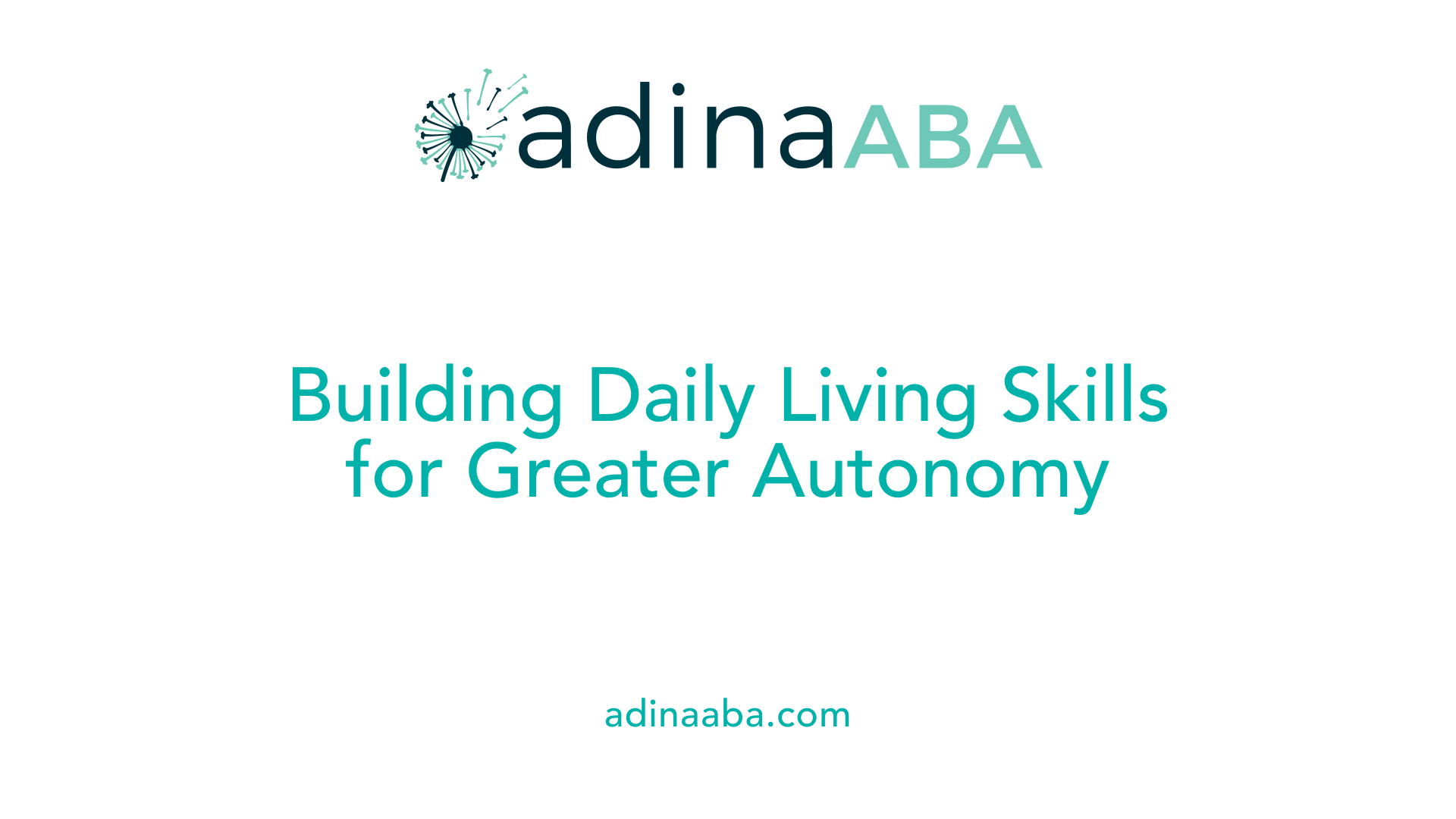Building independence in older autistic individuals

Understanding and Supporting Autonomy in Older Autistic Individuals
Building independence in older autistic individuals requires a nuanced approach that recognizes their unique strengths, challenges, and developmental trajectories. Effective strategies encompass skill development, environmental support, community involvement, and societal acceptance. This article explores conceptual frameworks, practical techniques, resources, and research-based practices to foster autonomy, promote well-being, and enhance quality of life for autistic adults.
Conceptual Foundation: Independence and Interdependence in Autistic Adults

What conceptual understanding underpins independence and interdependence in older autistic individuals?
The idea of independence for autistic adults is evolving beyond simply living alone or managing all daily tasks on their own. It involves a nuanced understanding that true self-sufficiency often coexists with, and indeed relies on, mutual support from family, friends, and community systems.
Independence in this context includes skills such as self-advocacy, self-management, and confidence to make personal choices. It means being able to pursue meaningful activities, handle daily routines, and express needs effectively. However, it does not mean complete isolation from others.
Interdependence plays a central role. It emphasizes that relying on support networks is a healthy and strategic part of functioning in society. Support systems—whether family, support services, or community resources—are viewed as enabling rather than hindering autonomy. These relationships can provide emotional, practical, and logistical help, all of which are essential for holistic well-being.
Supporting autistic adults involves balancing these two concepts: fostering independence through skill development and empowering individuals to engage in mutually supportive relationships. Recognizing that no person is entirely independent, and that interdependence can enhance quality of life, challenges outdated notions of complete self-reliance.
This perspective encourages a shift from traditional views where independence is seen as an absolute goal. Instead, it promotes flexible, respectful relationships that adapt to individual circumstances and cultural backgrounds. Embracing interdependence not only reflects real-world living but also enriches the social and emotional fabric of autistic adulthood, ensuring a more inclusive and supportive journey toward personal fulfillment.
The Importance of Developing Daily Living Skills

What is the importance of developing daily living skills for autistic individuals?
Building daily living skills is vital for autistic individuals because it directly supports their independence and overall well-being. By learning essential tasks such as personal hygiene, cooking, managing money, and navigating transportation, they gain the ability to function effectively in everyday life.
These skills boost self-esteem and confidence, helping individuals feel more in control of their lives. Mastery of daily routines encourages participation in community activities, fosters social inclusion, and opens doors to employment and educational opportunities.
Developing life skills also promotes physical and mental health, reduces reliance on caregivers, and prepares individuals for significant transitions like moving out of the parental home or starting a job. Structured programs, hands-on instruction, and the use of visual supports enhance learning and retention.
In summary, fostering these skills empowers autistic individuals to live more autonomous, resilient, and fulfilling lives, making daily life more manageable and providing opportunities for personal growth and community engagement.
Barriers and Challenges to Independence
Why might autistic individuals struggle with independence, and what challenges do they face?
Autistic individuals often encounter difficulties in achieving independence due to a mix of social, sensory, and executive functioning challenges. They may find it hard to interpret social cues, manage sensory sensitivities, or stay organized with daily routines. These hurdles can make everyday activities, like shopping or commuting, more overwhelming.
Societal stereotypes and systemic barriers further complicate independence. Many face a lack of supportive accommodations and limited access to tailored services, which are crucial for developing essential life skills. These systemic issues can restrict opportunities for employment, independent living, and social participation.
Mental health concerns, such as anxiety, depression, and past traumas, also significantly affect their ability to live autonomously. These challenges are compounded by societal attitudes—stigma, ableism, and misinformation—that hinder acceptance and support.
In addition, navigating complex environments like public transport or community settings can be daunting without proper skills or support. Many autistic adults define independence broadly, incorporating emotional resilience, social connection, and self-advocacy, which are often supported by coping strategies, support networks, and targeted interventions.
To foster greater independence, society must provide accessible resources, inclusive policies, and an understanding of individual needs. Tailored behavioral therapies, assistive technologies, and supportive housing options play vital roles. Ultimately, increasing societal awareness and acceptance is essential for enabling autistic individuals to pursue meaningful, autonomous lives.
Practical Strategies for Building Autonomy

What are effective strategies and tips for building independence in older autistic individuals?
Developing independence in autistic adults involves a multifaceted approach tailored to each individual’s needs. One of the most effective ways is providing targeted life skills training. This training often includes hands-on activities for self-care, household chores, money management, and safety skills. For example, using visual supports such as checklists and schedules makes complex routines more manageable and clear.
Community-based programs play a vital role by offering real-life practice environments where individuals can learn and apply these skills. These programs often involve community outings for shopping, transportation, and employment prep, helping to build confidence and functional abilities.
Supporting self-management and self-monitoring is essential. Teaching individuals to observe and track their behaviors—using tools like checklists or digital apps—helps in setting and achieving personal goals. Such practices foster a sense of control and self-advocacy.
Resources like supported decision-making, tailored housing options, and employment services are critical supports during this transition. For instance, legal arrangements like guardianship or supported decision-making empower autonomy while providing protections.
Using communication aids such as augmentative and alternative communication (AAC) devices can support self-advocacy, safety, and social interaction. Additionally, goal-setting and gradual responsibility increases help build confidence over time.
Overall, these strategies, combined with a personalized approach and consistent support, help foster lasting independence for autistic adults, promoting a higher quality of life and greater societal participation.
The Role of Support Technologies and Visual Tools

How can independence be increased in autistic individuals?
Enhancing independence for autistic individuals involves an integrated approach that leverages various support technologies and visual tools. Communication devices, including augmentative and alternative communication (AAC) systems such as speech devices, PECS (Picture Exchange Communication System), and sign language, empower individuals to express their needs and advocate for themselves.
Structured routines supported by visual schedules and ‘to do’ lists help manage transitions, improve task completion, and foster decision-making skills. These visual supports typically answer four questions: what to do, how much work is involved, progress tracking, and what comes next, making daily activities more predictable and manageable.
Using apps and reminders plays a crucial role in organizing daily tasks. Visual and auditory cues from smartphones or dedicated devices assist individuals in waking up on time, taking medication, or completing chores. These digital tools support independence by providing consistent cues and reducing reliance on caregivers.
Sensory tools, such as weighted blankets, noise-canceling headphones, and calming lighting, help regulate sensory overload. Support devices like safety wearables equipped with GPS can ensure safety during community outings, helping navigate complex environments while providing peace of mind.
Combining these technologies with tailored instruction—such as gradually fading support and practicing real-life scenarios—encourages sustained independence across settings. The strategic integration of communication aids, visual task management, sensory regulation tools, and safety devices creates a comprehensive system that significantly enhances the autonomy and quality of life for autistic adults.
Supporting Transition and Lifelong Growth
How does supporting autistic adults through life transitions involve increasing independence?
Supporting autistic adults as they navigate significant life changes focuses on enhancing their ability to function independently. This involves teaching self-management skills that enable individuals to set goals, monitor their progress, and develop routines in areas such as employment, personal relationships, leisure activities, and health management. Using visual aids, checklists, and self-monitoring tools reinforces these skills, making daily tasks more manageable.
Transition planning is a crucial component, requiring collaboration among families, educators, support agencies, and the individuals themselves. By prioritizing personal preferences and strengths, this teamwork ensures the support provided aligns with each person’s unique needs. Integrating vocational training and opportunities for work-based learning prepares individuals for employment and promotes financial independence.
Legal frameworks like supported decision-making empower adults to make autonomous choices about their lives, rather than relying solely on guardianship. Regularly assessing progress and celebrating achievements motivate continued growth and adaptability to new life stages. Overall, empowering autistic adults involves a comprehensive approach that fosters skills, supports independence, and respects their personal aspirations.
Resources, Support Systems, and Policy Frameworks

Do autistic adults live independently, and what support resources are available?
Many autistic adults successfully live independently within their communities. Some manage on their own, handling daily routines and employment, while others require different levels of support tailored to their needs. The variety of available housing options is broad but often limited by shortages and affordability issues.
Supportive housing settings include independent apartments, supported living arrangements, shared housing, group homes, and in-home assistance. These options help foster autonomy while providing necessary safety nets. Organizations like Easterseals are instrumental in offering employment help, life skills training, social activities, and structured therapies aimed at increasing independence and improving quality of life.
Government programs and nonprofit entities play a vital role in providing resources such as rental assistance, employment support, social integration services, and legal advice for supported decision-making. Examples include housing subsidies, job training initiatives, and legal frameworks that respect individual autonomy.
Despite these resources, a significant challenge remains—the limited availability of affordable, tailored housing solutions that meet the diverse needs of autistic adults. Improving access and expanding these supports is essential to ensure more individuals can thrive independently.
In sum, while many autistic adults live independently and benefit from numerous support opportunities, ongoing efforts are necessary to address housing shortages and to continue developing personalized services that promote lasting independence.
Fostering a Supportive Environment for Lifelong Independence
Promoting independence in older autistic individuals is a multifaceted endeavor that combines skill development, environmental supports, societal acceptance, and legal safeguards. Recognizing the importance of both independence and interdependence allows for a more inclusive, respectful approach that realizes each person’s potential while respecting individual needs. Through targeted interventions, community engagement, assistive technologies, and policy support, we can empower autistic adults to lead autonomous, fulfilling lives. Building a future where independence is viewed as a dynamic, lifelong process requires ongoing collaboration among families, practitioners, policymakers, and communities.
References
- Ten Ways to Build Independence | Autism Speaks
- 20 Essential Resources for Autistic Adults that Support Independence
- Increasing Independence in Adults with Autism Spectrum Disorders
- Increasing Independence of Adults With Autism in Community ...
- Life skills for autism | Autism Speaks
- Daily Living Skills: A Key to Independence for People with Autism
- Experiencing Independence: Perspectives from Autistic Adults
More Resources
Expert Clinicians
Get started today ->

.jpg)


.jpg)

